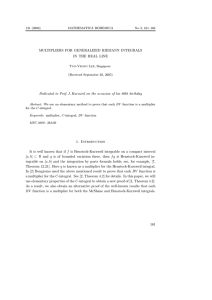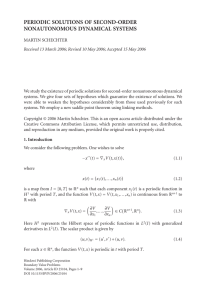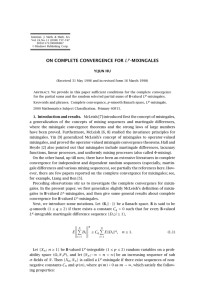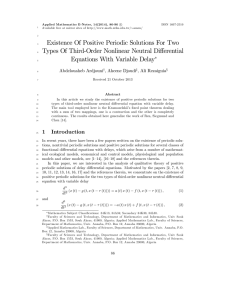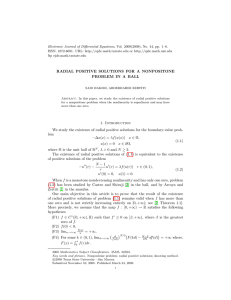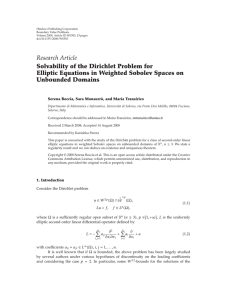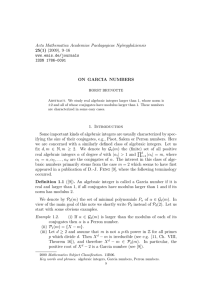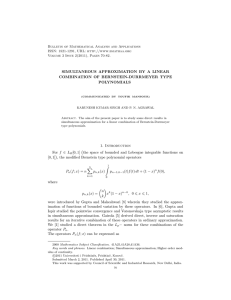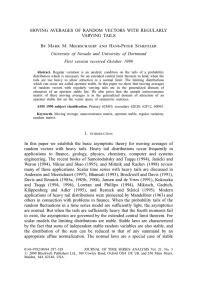Innovations algorithm asymptotics for periodically stationary time series with heavy tails
advertisement
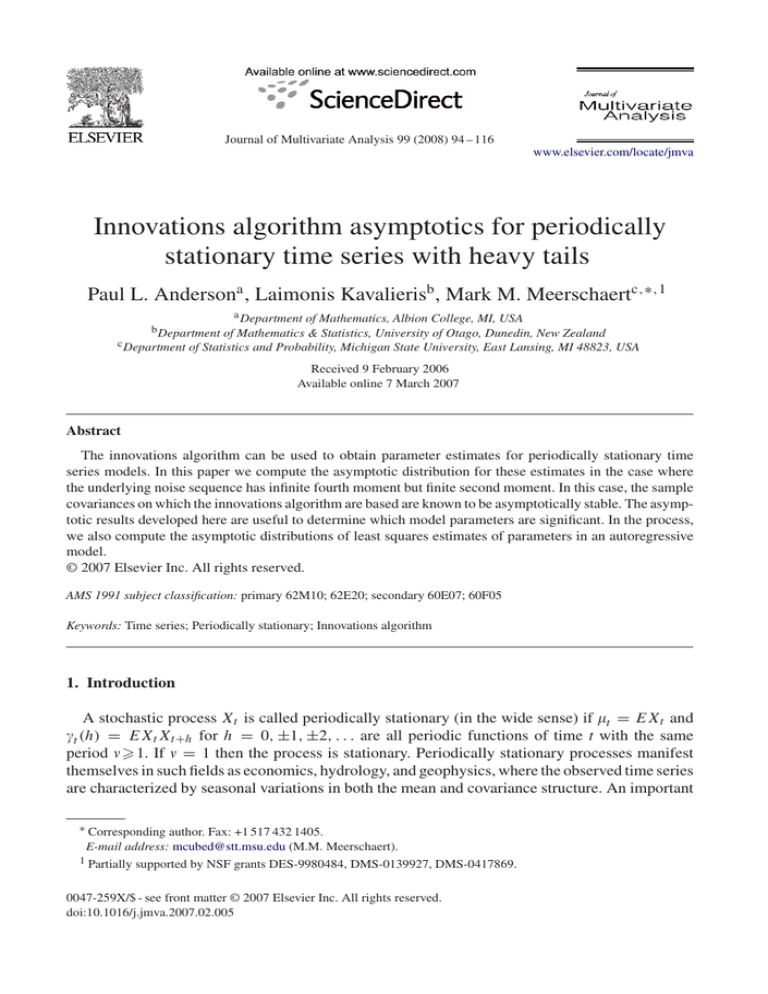
Journal of Multivariate Analysis 99 (2008) 94 – 116
www.elsevier.com/locate/jmva
Innovations algorithm asymptotics for periodically
stationary time series with heavy tails
Paul L. Andersona , Laimonis Kavalierisb , Mark M. Meerschaertc,∗,1
a Department of Mathematics, Albion College, MI, USA
b Department of Mathematics & Statistics, University of Otago, Dunedin, New Zealand
c Department of Statistics and Probability, Michigan State University, East Lansing, MI 48823, USA
Received 9 February 2006
Available online 7 March 2007
Abstract
The innovations algorithm can be used to obtain parameter estimates for periodically stationary time
series models. In this paper we compute the asymptotic distribution for these estimates in the case where
the underlying noise sequence has infinite fourth moment but finite second moment. In this case, the sample
covariances on which the innovations algorithm are based are known to be asymptotically stable. The asymptotic results developed here are useful to determine which model parameters are significant. In the process,
we also compute the asymptotic distributions of least squares estimates of parameters in an autoregressive
model.
© 2007 Elsevier Inc. All rights reserved.
AMS 1991 subject classification: primary 62M10; 62E20; secondary 60E07; 60F05
Keywords: Time series; Periodically stationary; Innovations algorithm
1. Introduction
A stochastic process Xt is called periodically stationary (in the wide sense) if t = EXt and
t (h) = EXt Xt+h for h = 0, ±1, ±2, . . . are all periodic functions of time t with the same
period 1. If = 1 then the process is stationary. Periodically stationary processes manifest
themselves in such fields as economics, hydrology, and geophysics, where the observed time series
are characterized by seasonal variations in both the mean and covariance structure. An important
∗ Corresponding author. Fax: +1 517 432 1405.
E-mail address: mcubed@stt.msu.edu (M.M. Meerschaert).
1 Partially supported by NSF grants DES-9980484, DMS-0139927, DMS-0417869.
0047-259X/$ - see front matter © 2007 Elsevier Inc. All rights reserved.
doi:10.1016/j.jmva.2007.02.005
P.L. Anderson et al. / Journal of Multivariate Analysis 99 (2008) 94 – 116
95
class of stochastic models for describing periodically stationary time series are the periodic ARMA
models, in which the model parameters are allowed to vary with the season. Periodic ARMA
models are developed by many authors including [1,2,4–7,20,22–24,26,28,30,31,33–41].
Anderson et al. [5] develop the innovations algorithm for periodic ARMA model parameters.
Anderson and Meerschaert [4] develop the asymptotics necessary to determine which of these
estimates are statistically different from zero, under the classical assumption that the noise sequence has finite fourth moment. In this paper, we extend those results to the case where the
noise sequence has finite second moment but infinite fourth moment. This case is important in
applications to river flows, see for example Anderson and Meerschaert [3]. In that case, Anderson
and Meerschaert [2] proved that the sample autocovariances, the basis for the innovations algorithm estimates of the model parameters, are asymptotically stable. Surprisingly, the innovations
estimates themselves turn out to be asymptotically normal, although the rate of convergence (in
terms of the number of iterations of the innovations algorithm) is slower than in the finite fourth
moment case. Brockwell and Davis [13] discuss asymptotics of the innovations algorithm for
stationary time series, using results of Berk [8] and Bhansali [10]. However, all of these results
assume a finite fourth moment for the noise sequence. Hence our results seem to be new even in
the stationary case when the period = 1. Since our technical approach extends that of [13], we
also need to develop periodically stationary analogues of results in [8,10] for the infinite fourth
moment case. In particular, we obtain asymptotics for the least squares estimates of a periodically
stationary process. Although the innovations estimates are more useful in practice, the asymptotics
of the least squares estimates are also of some independent interest.
2. The innovations algorithm
The periodic ARMA process {X̃t } with period (denoted by PARMA (p, q)) has representation
p
Xt −
t (j )Xt−j = εt −
j =1
q
t (j )εt−j ,
(1)
j =1
where Xt = X̃t − t and {εt } is a sequence of random variables with mean zero and standard
deviation t such that {−1
t εt } is i.i.d. The autoregressive parameters t (j ), the moving average
parameters t (j ), and the residual standard deviations t are all periodic functions of t with the
same period 1. We also assume that the model admits a causal representation
Xt =
∞
t (j )εt−j ,
(2)
j =0
where t (0) = 1 and
εt =
∞
∞
j =0 |t (j )|
t (j )Xt−j ,
< ∞ for all t, and satisfies an invertibility condition
(3)
j =0
where t (0) = 1 and ∞
j =0 |t (j )| < ∞ for all t. We will say that the i.i.d. noise sequence t =
ε
is
RV()
if
P
[|
|
−1
t
t > x] varies regularly with index − and P [
t > x]/P [|
t | > x] → p
t
for some p ∈ [0, 1]. The case where E|
t |4 < ∞ was treated in Anderson and Meerschaert
[4]. In this paper, we assume that the noise sequence {
t } is RV() for some 2 < < 4. This
96
P.L. Anderson et al. / Journal of Multivariate Analysis 99 (2008) 94 – 116
assumption implies that E|
t |p < ∞ if 0 < p < , in particular the variance of εt exists. With
this technical condition, Anderson and Meerschaert [2] show that the sample autocovariance is a
consistent estimator of the autocovariance, and asymptotically stable with tail index /2. Stable
laws and processes are comprehensively treated in, e.g., Feller [16], Samorodnitsky and Taqqu
[29], and Meerschaert and Scheffler [25].
(i)
Let X̂i+k = PHk,i Xi+k denote the one-step predictors, where Hk,i = sp{Xi , . . . , Xi+k−1 },
k 1, and PHk,i is the orthogonal projection onto this space, which minimizes the mean squared
error
(i)
(i)
vk,i = Xi+k − X̂ i+k 2 = E(Xi+k − X̂ i+k )2 .
Recall that t (h) = Cov(Xt , Xt+h ), h = 0, ±1, ±2, . . . . Then
(i)
(i)
(i)
X̂i+k = k,1 Xi+k−1 + · · · + k,k Xi ,
k 1,
(4)
where the vector of coefficients k = (k,1 , . . . , k,k ) solves the prediction equations
(i)
(i)
(i)
(i)
(i)
k,i k = k
(5)
with k = (i+k−1 (1), i+k−2 (2), . . . , i (k)) and
(i)
k,i = i+k− ( − m) ,m=1,...,k
(6)
is the covariance matrix of (Xi+k−1 , . . . , Xi ) for each i = 0, . . . , − 1. Let
ˆ i () = N −1
N−1
(7)
Xj +i Xj +i+
j =0
denote the (uncentered) sample autocovariance, where Xt = X̃t − t . If we replace the autocovariances in the prediction equation (5) with their corresponding sample autocovariances, we
(i)
(i)
obtain the estimator ˆ k,j of k,j .
Because the scalar-valued process Xt is non-stationary, the Durbin–Levinson algorithm (see,
ˆ (i) does not apply. However, the innovations algoe.g., [14, Proposition 5.2.1]) for computing k,j
rithm (see, e.g., [14, Proposition 5.2.2]) still applies to a non-stationary process. Writing
(i)
X̂i+k =
k
j =1
(i)
(i)
k,j (Xi+k−j − X̂i+k−j )
(8)
(i)
yields the one-step predictors in terms of the innovations Xi+k−j − X̂i+k−j . Proposition 4.1 of
Lund and Basawa [22] shows that if 2i > 0 for i = 0, . . . , −1, then for a causal PARMA (p, q)
process the covariance matrix k,i is non-singular for every k 1 and each i. Anderson et al. [5]
show that if EXt = 0 and k,i is nonsingular for each k 1, then the one-step predictors X̂i+k ,
P.L. Anderson et al. / Journal of Multivariate Analysis 99 (2008) 94 – 116
97
k 0, and their mean-square errors vk,i , k 1, are given by
v0,i = i (0),
⎡
k,k− = (v,i )−1 ⎣i+ (k − ) −
(i)
vk,i = i+k (0) −
k−1
j =0
−1
j =0
⎤
,−j k,k−j vj,i ⎦ ,
(i)
(i)
(i)
(k,k−j )2 vj,i ,
(i)
(9)
(i)
(i)
(i)
(i)
(i)
where (9) is solved in the order v0,i , 1,1 , v1,i , 2,2 , 2,1 , v2,i , 3,3 ,3,2 , 3,1 , v3,i , . . . . The results
in [5] show that
(i−k)
k,j
→ i (j ),
vk,i−k → 2i ,
(i−k)
k,j
→ −i (j )
(10)
as k → ∞ for all i, j , where j = j mod .
If we replace the autocovariances in (9) with the corresponding sample autocovariances (7),
(i)
we obtain the innovations estimates ˆ k, and v̂k,i . Similarly, replacing the autocovariances in (5)
with the corresponding sample autocovariances yields the least squares or Yule–Walker estimators
ˆ (i) . The consistency of these estimators was also established in [5]. Suppose that {Xt } is the
k,
mean zero PARMA process with period given by (1). Assume that the spectral density matrix
f () of the equivalent vector ARMA process is such that mz z z f ()z Mz z, − , for
some m and M such that 0 < m M < ∞ and for all z in R . Recall that the i.i.d. noise sequence
t = −1
t εt is RV() for some 2 < < 4, viz., the noise sequence has infinite fourth moment but
finite variance, and define
aN = inf{x : P (|
t | > x) < 1/N }
(11)
a regularly varying sequence with index 1/, see for example Proposition 6.1.37 in [25]. If k is
2 /N → 0 as N → ∞ and k → ∞, then
chosen as a function of the sample size N so that k 5/2 aN
the results in Theorems 3.5–3.7 and Corollary 3.7 of [5], specific to the infinite fourth moment
case, also show that
(i−k) P
ˆ k,j
→ i (j ),
P
v̂k,i−k → 2i ,
P
ˆ (i−k) →
−i (j )
k,j
(12)
for all i, j . This yields a practical method for estimating the model parameters, in the case of
infinite fourth moments. The results of Section 3 can then be used to determine which of these
model parameters are statistically significantly different from zero.
98
P.L. Anderson et al. / Journal of Multivariate Analysis 99 (2008) 94 – 116
3. Asymptotic results
In this section, we compute the asymptotic distribution for the innovations estimates of the
parameters in a periodically stationary time series (2) with period 1. In the process, we also
obtain the asymptotic distribution of the least squares estimates. For any periodically stationary
time series, we can construct an equivalent (stationary) vector moving average process in the
following way: Let Zt = (εt , . . . , ε(t+1)−1 ) and Yt = (Xt , . . . , X(t+1)−1 ) , so that
Yt =
∞
j Zt−j ,
(13)
j =−∞
where j is the × matrix with i entry i (t + i − ), and we number the rows and columns
0, 1, . . . , −1 for ease of notation. Also, let N (m, C) denote a Gaussian random vector with mean
m and covariance matrix C, and let ⇒ indicate convergence in distribution. Our first result gives
the asymptotics of the least squares estimates in the case where the noise sequence has heavy tails
with an infinite fourth moment but finite second moment. The corresponding result in the case
where the noise sequence has finite fourth moments was obtained by Anderson and Meerschaert
[4]. A similar result was obtained in the finite fourth moment case by Lewis and Reinsel [21]
for vector autoregressive models, however, the prediction problem here is different. For example,
suppose that (2) represents monthly data with = 12. For a periodically stationary model, the
prediction equations (4) use observations for earlier months in the same year. For the equivalent
vector moving average model, the prediction equations use only observations from past years.
Theorem 3.1. Suppose that the periodically stationary moving average (2) is causal, invertible, the i.i.d. noise sequence t = −1
t εt is RV(), and that for some 0<m M<∞ we have
mz z z f ()z Mz z for all −, and all z in R , where f () is the spectral density
matrix of the equivalent vector moving average process (13). If k = k(N ) → ∞ as N → ∞ with
2 /N → 0 where a is defined by (11), and if
k 3 aN
N
N
1/2
∞
| (k + j )| → 0
for = 0, 1, . . . , − 1
(14)
j =1
then for any fixed positive integer D
i−k
N 1/2 i (u) + ˆ k,u : 1 u D, i = 0, . . . , − 1 ⇒ N (0, )
(15)
where
= diag(20 (0) , 21 (1) , . . . , 2−1 (−1) )
(16)
with
((i) )u,v =
m−1
i−m+s (s)i−m+s (s + |v − u|)−2
i−m+s
s=0
and m = min(u, v), 1 u, v D.
(17)
P.L. Anderson et al. / Journal of Multivariate Analysis 99 (2008) 94 – 116
99
In Theorem 3.1, note that (i) is a D × D matrix and the D-dimensional vector given in (15)
is ordered
ˆ 0−k , . . . , 0 (D) + ˆ 0−k , . . . , −1 (1) + ˆ −1−k , . . . , −1 (D)
N 1/2 (0 (1) + k,D
k,1
k,1
−1−k +ˆ k,D
).
Note also that aN is roughly on the order of N 1/ for some 2 < < 4 so that the condition on k
is essentially that k 3 grows slower than N 1−2/ . In practice, on the boundary = 2 + , > 0,
we look for the value k in the innovations algorithm where the estimates have stabilized. Next we
present our main result, giving asymptotics for innovations estimates of a periodically stationary
time series.
Theorem 3.2. Suppose that the periodically stationary moving average (2) is causal, invertible, the i.i.d. noise sequence t = −1
t εt is RV(), and that for some 0<m M<∞ we have
mz z z f ()z Mz z for all − , and all z in R , where f () is the spectral density
matrix of the equivalent vector moving average process (13). If k = k(N ) → ∞ as N → ∞ with
2 /N → 0 where a is defined by (11), and if
k 3 aN
N
N 1/2
∞
| (k + j )| → 0
for = 0, 1, . . . , − 1
(18)
j =1
then
(i−k)
N 1/2 (ˆ k,u
− i (u) : u = 1, . . . , D, i = 0, . . . , − 1) ⇒ N (0, V )
(19)
V = A diag(20 D (0) , . . . , 2−1 D (−1) )A ,
(20)
where
A=
D−1
En [D −n(D+1)] ,
(21)
n=0
⎛ n
D−n
n
⎝
En = diag 0, . . . , 0, 0 (n), . . . , 0 (n), 0, . . . , 0,
⎞
⎟
(n), . . . , 1 (n), . . . , 0, . . . , 0, −1 (n), . . . , −1 (n)⎠ ,
1
D−n
n
(22)
D−n
−2
−2
D (i) = diag(−2
i−1 , i−2 , . . . , i−D ),
and an orthogonal D × D cyclic permutation matrix,
⎛
⎞
0 1 0 0 ··· 0
⎜0 0 1 0 · · · 0⎟
⎜. . . .
.. ⎟
. . . .
=⎜
.⎟
⎜. . . .
⎟.
⎝0 0 0 0 · · · 1⎠
1 0 0 0 ··· 0
(23)
(24)
100
P.L. Anderson et al. / Journal of Multivariate Analysis 99 (2008) 94 – 116
Note that 0 is the D × D identity matrix and − ≡ ( ) . Matrix multiplication yields
the following corollary.
Corollary 3.3. Regarding Theorem 3.2, in particular, we have that
u−1
−2
2
1/2 ˆ (i−k)
2
− (u)) ⇒ N 0, (n)
N (
i
k,u
i−n i
i−u
(25)
n=0
Remark. Corollary 3.3 also holds the asymptotic result for the second-order stationary process
where the period is just = 1. In this case 2i = 2 so (25) becomes
N
1/2
u−1
2
ˆ
(k,u − (u)) ⇒ N 0,
(n)
n=0
which extends Theorem 2.1 in [13] to the case where the noise sequence has only moments of
order 2 + , > 0.
4. Proofs
Theorem 3.1 depends on modulo arithmetic which requires our i − k-notation. Since the
lemmas in this section do not have this dependence, we proceed with the less cumbersome inotation.
Lemma 4.1. Let k = (i+k (1), . . . , i+k (k)) and Xj (k) = (Xj +i+k−1 , . . . , Xj +i ) . Then
for all i = 0, . . . , − 1 and k 1 we have
(i)
(i)
k
(i)
N−1
(i)
(i)
−1 1
ˆ
ˆ
+ k = (k,i )
Xj (k)εj +i+k,k
N
(26)
j =0
where εt,k = Xt + t (1)Xt−1 + · · · + t (k)Xt−k .
Proof. The least squares equations are
−1
(i)
ˆ (i) = ˆ k,i
ˆ k
k
where
ˆ k,i
⎛
⎞
N−1 Xj +i+k−1
1 ⎝
.
⎠ (Xj +i+k−1 , . . . , Xj +i )
..
=
N
j =0
Xj +i
and
(i)
ˆ k
⎛
⎞
N−1 Xj +i+k−1
1 ⎝
.
⎠ Xj +i+k
..
=
N
j =0
Xj +i
(27)
P.L. Anderson et al. / Journal of Multivariate Analysis 99 (2008) 94 – 116
101
from Eq. (7). Thus,
⎛X
⎞
j +i+k−1
N−1
1
..
ˆ k,i (i) + ˆ (i) =
⎝
⎠
k
k
.
N
j =0
Xj +i
⎧
⎫
⎛
⎞
i+k (1)
⎨
⎬
..
⎠ + Xj +i+k
× (Xj +i+k−1 , . . . , Xj +i ) ⎝
.
⎩
⎭
i+k (k)
⎛
⎞
N−1 Xj +i+k−1
1 ⎝
..
⎠ εt,k
=
.
N
j =0
Xj +i
since Xj +i+k + i+k (1)Xj +i+k−1 + · · · + i+k (k)Xj +i = εt,k by definition. Then, using the
least squares equations (27), we have
−1 (i)
ˆ (i) = ˆ k,i
ˆ k,i (i) + ˆ (i)
k + k
k
k
⎛X
⎞
j
+i+k−1
−1 1 N−1
..
ˆ k,i
⎝
⎠ εt,k
= .
N
j =0
Xj +i
N−1
−1 1 (i)
ˆ k,i
Xj (k)εt,k
= N
j =0
which finishes the proof of Lemma 4.1.
Lemma 4.2. Let ci (),
di () for = 0, 1, 2, . . . and i = 0, . . . , − 1 be arbitrary sequences of
∞
real numbers such that ∞
=0 |ci ()| < ∞ and
=0 |di ()| < ∞, and let
ut +i =
∞
and
ci (k)εt +i−k
vt +j =
k=0
∞
dj (m)εt +j −m
m=0
and set
Ci =
∞
|ci (k)| and
Dj =
k=0
∞
|dj (m)|
m=0
for 0 i, j < . Then
M
ut +i vt +j MCD,
E
t=1
where C = max(Ci ), D = max(Dj ), and = maxt,t (t t 21 , 2t ) where 1 = E(|
t |).
Proof. Write
M
M
ut +i vt +j ,
ut +i vt +j E
E
t=1
t=1
(28)
102
where
P.L. Anderson et al. / Journal of Multivariate Analysis 99 (2008) 94 – 116
∞ ∞
ut +i vt +j = ci (k)dj (m)εt +i−k εt +j −m k=0 m=0
∞
∞ ci (k)dj (m) εt +i−k εt +j −m .
k=0 m=0
Then
∞ ∞
ci (k)dj (m) E εt +i−k εt +j −m ,
E ut +i vt +j k=0 m=0
where
E εt +i−k εt +j −m =
E|εt +i−k |E|εt +j −m | if i − k = j − m,
if i − k = j − m.
E(εt2+i−k )
Since E|εt +i−k | = E|i−k −1
i−k εt +i−k | = E|i−k t +i−k | = i−k 1 , we have that
i−k j −m 21 if i − k = j − m,
E εt +i−k εt +j −m =
if i − k = j − m.
2i−k
Hence,
∞
∞
dj (m) CD
|ci (k)|
E ut +i vt +j k=0
m=0
for 0 i, j < , and then (28) follows easily, which finishes the proof of Lemma 4.2.
Lemma 4.3. For εt,k as in Lemma 4.1 and ut +i as in Lemma 4.2 we have
N−1
∞
E
ut +i (εt +,k − εt + ) NCB max
(k + j ),
j =1
t=0
where C, are as in Lemma 4.2 and B =
−1 ∞
i=0
=0 |i ()|.
Proof. Write
∞
εt + − εt +,k =
=
=
m=k+1
∞
m=k+1
∞
(m)Xt +−m
(m)
∞
−m (r)εt +−m−r
r=0
d,k (k + j )εt +−k−j ,
j =1
where
d,k (k + j ) =
j
s=1
(k + s)−(k+s) (j − s).
(29)
P.L. Anderson et al. / Journal of Multivariate Analysis 99 (2008) 94 – 116
103
Since {Xt } is causal and invertible,
∞
∞ j
|d,k (k + j )| =
(k + s)−(k+s) (j − s)
j =1
j =1 s=1
=
∞
s=1
∞
| (k + s)|
| (k + s)|
s=1
∞
j =s
∞
|−(k+s) (j − s)|
|−(k+s) (r)|
r=0
is finite, and hence we have ∞
j =1 |d,k (k + j )| < ∞. Now apply Lemma 4.2 with vt + =
εt +,k − εt + to see that
N−1
E
ut +i (εt +,k − εt + ) NCD,k NCDk ,
t=0
where D,k =
D,k =
∞
j =1 |d,k (k
∞
+ j )| and Dk = max(D,k : 0 < ). Next compute
∞
∞
|d,k (k + j )| | (k + s)|
|−(k+s) (r)|
j =1
s=1
r=0
∞
∞
−1 | (k + s)|
s=1
∞
=B
|i (r)|
j =0 r=0
| (k + s)|
s=1
and (29) follows easily.
The next lemma employs the matrix 1-norm given by
M1 = max Mx1 ,
x1 =1
where x1 = |x1 | + · · · + |xk | is the vector 1-norm (see, e.g., [17]). (i)
Lemma 4.4. For εt,k and Xj (k) as in Lemma 4.1 we have that
E N −1
N−1
j =0
(i)
Xj (k)(εj +i+k,k − εj +i+k )
where A = B maxi
∞
=0 |i ()|
Ak max
1
∞
| (k + j )|,
(30)
j =1
and B is from Lemma 4.3.
Proof. Rewrite the left-hand side of (30) in the form
N −1
k−1
s=0
E
N−1
t=0
Xt +i+s (εt +i+k,k − εt +i+k )
1
and apply
Lemma 4.3 k times with ut +i = Xt +i+s for each s = 0, . . . , k − 1 and C =
maxi ∞
=0 |i ()| to obtain the upper bound of (30). 104
P.L. Anderson et al. / Journal of Multivariate Analysis 99 (2008) 94 – 116
Lemma 4.5. Suppose that the periodically stationary moving average (2) is causal, invertible,
and that the noise sequence t = −1
t εt is RV() with 2 < < 4. Assume that for some 0 <
mM < ∞ we have mz z z f ()z Mz z for all − , and all z in R , where f () is the
spectral density matrix of the equivalent vector moving average process (13). If k = k(N ) → ∞
2 /N → 0 where a is defined by (11) and (14) holds then
as N → ∞ with k 3 aN
N
(i)
ˆ (i) ) − N −1/2 b(k) −1
N 1/2 b(k) (k + k,i
k
N
−1
j =0
P
(i)
Xj (k)εj +i+k → 0
(31)
for any b(k) = (bk1 , . . . , bkk ) such that b(k)1 remains, of k and Xj (k) is from Lemma 4.1.
(i)
Proof. Using (26) the left-hand side of (31) can be written as
⎡
⎤
N−1
N−1
(i)
(i)
Xj (k)εj +i+k,k − −1
Xj (k)εj +i+k ⎦ = I1 + I2 ,
N −1/2 b(k) ⎣ˆ −1
k,i
k,i
j =0
where
j =0
⎡
ˆ −1 − −1
I1 = N −1/2 b(k) ⎣ k,i
k,i
⎡
I2 = N −1/2 b(k) ⎣−1
k,i
N
−1
j =0
N−1
j =0
⎤
Xj (k)εj +i+k,k ⎦ ,
(i)
⎤
Xj (k)(εj +i+k,k − εj +i+k )⎦
(i)
so that
ˆ −1 − −1 1 ·
|I1 | N −1/2 b(k)1 · k,i
k,i
N−1
j =0
(i)
= J1 · J2 · J3 ,
Xj (k)εj +i+k,k
where J1 = b(k)1 is bounded by assumption, J2 =
1
ˆ −1 − −1 1 , and J3
k
k,i
k,i
=
N 1/2
k
1
N
N−1
j =0
(i)
Xj (k)εj +i+k,k .
1
ˆ −1 − −1 1 → 0 in probability. The proof is similar to
Next we will show that J2 = k
k,i
k,i
−1
ˆ −1
Theorem 3.1 in Anderson et al. [5]. Define pki = −1
k,i 1 , qki = k,i − k,i 1 , and Qk,i =
ˆ k,i − k,i 1 . Then we have
qki (qki + pki )Qki pki
(32)
exactly as in the proof of Theorem 3.1 in [5], and we want to show that kqki → 0 in probability.
From Theorem A.2 in [5] we have, for some C > 0, that
−2
E NaN
(ˆi () − i ()) C
uniformly over all i = 0, . . . , − 1, all integers and all positive integers N. Then, using the
bound
EA1 = E max
1j k
k
i=1
|aij |k max E|aij |kC
i,j
P.L. Anderson et al. / Journal of Multivariate Analysis 99 (2008) 94 – 116
105
2 C/N for all i, k, and N. Since
in the proof of Theorem 3.5 in [5] it follows that EQki kaN
−1
1/2
pki k k,i 2 we also have using Theorem A.1 from [5] that for some m > 0, pki k 1/2 /(2m)
for all i and k. Then
2C
k 3/2 aN
E(pki Qki ) = pki EQki →0
2N m
2 /N → 0. Then it follows from the Markov inequality
as k, N → ∞ since we are assuming k 3 aN
that pki Qki → 0 in probability. If pki Qki < 1 then 1 − pki Qki > 0, and then it follows easily
from (32) that
kqki 2Q
kpki
ki
.
1 − pki Qki
Since pki k 1/2 /2m, we have
2C
k 2 aN
2
E kpki
→0
Qki k ·
(2m)2 N
2 Q → 0 in probability. As p Q → 0 in probability, it follows that
so that kpki
ki
ki ki
2Q
kpki
P
ki
→ 0.
1 − pki Qki
Now the remainder of the proof that J2 → 0 in probability is exactly the same conditioning
argument as in Theorem 3.1 of [5]. As for the remaining term in I1 , write
N−1
N 1/2 1 (i)
Xj (k)εj +i+k,k
J3 =
k
N
j =0
1
so that E(J3 )E(J31 ) + E(J32 ) where
J31 =
N−1
N 1/2 1 (i)
Xj (k)εj +i+k
k
N
j =0
J32 =
N 1/2
k
1
N
N−1
j =0
and
1
(i)
Xj (k)(εj +i+k,k − εj +i+k )
.
1
Lemma 4.4 implies that
E(J32 )
∞
∞
s=1
s=1
N 1/2
| (k + s)| = N 1/2 A max
| (k + s)| → 0,
Ak max
k
where the maximum is taken over = 0, . . . , − 1. Also
N 1/2 1/2
1 (i)
Xj (k)εj +i+k
k E
k
N
j =0
2
#
$
2
! "1/2 $
N−1
$
N
1 (i)
%E
Xj (k)εj +i+k
k
N
N−1
E(J31 ) j =0
2
106
P.L. Anderson et al. / Journal of Multivariate Analysis 99 (2008) 94 – 116
#
⎡⎛
$
⎞2 ⎤
! "1/2 $
N−1
k−1
$ 1 ⎢ N
⎥
$
=
E ⎣⎝
Xj +i+t εj +i+k ⎠ ⎦
%N2
k
j =0
t=0
#
$
k−1 N−1
$ 1 $
=%
E(Xj2+i+t )E(εj2+i+k )
kN
t=0 j =0
#
$
k−1
N
−1
$
$
= %k −1
i+t (0) · N −1
2i+k
j =0
t=0
√
so that E(J31 ) D where D = maxi i (0) · maxi 2i . Thus E(J3 ) < ∞, J1 is bounded, and
J2 → 0 in probability. Then it is easy to show that I1 → 0 in probability.
Next write
I2 = N −1/2
N−1
uj +i+k−1 (εj +i+k,k − εj +i+k ),
j =0
where uj +i+k−1 = b(k) −1
k,i Xj (k). Then
(i)
−1
Var(uj +i+k−1 ) = E(u2j +i+k−1 ) = b(k) −1
k,i E[Xj (k)Xj (k) ]k,i b(k)
(i)
(i)
2
= b(k) −1
k,i b(k) b(k)2 /(2m)
(i)
by Theorem A.1 in [5], since k,i is the covariance matrix of Xj (k). Hence by Lemma 4.3,
E|I2 | = Constant · N 1/2 max
∞
| (k + j )| → 0
j =1
for = 0, . . . , − 1 by (14). Then I2 → 0 in probability, which finishes the proof of Lemma 4.5.
Proof of Theorem 3.1. Define eu (k) to be the k dimensional vector with 1 in the uth place and
zeros elsewhere. Let
(i−k)
wuj,k
= eu (k) −1
k,i−k Xj
(i−k)
(k)εj +i−k+k
(33)
.
(34)
so that
(i−k)
tN,k
(u) = N −1/2
(i−k)
Here Xj
N−1
j =0
(i−k)
wuj,k
(k) = [Xj +i−k+k−1 , . . . , Xj +i−k ] and
(i−k)
k,i−k = E{Xj
(i−k)
(k)Xj
(i−k)
(k) }
(35)
thus for i, u, k fixed, wuj,k are stationary martingale differences since the first two terms in
(33) are non-random and do not depend on j while the third term is in the linear span of εs ,
P.L. Anderson et al. / Journal of Multivariate Analysis 99 (2008) 94 – 116
(i−k)
s < j + i − k + k due to the causality assumption. Then E{wuj,k
(i −k)
wvj ,k
107
} = 0 unless
j + i − k = j + i − k
because, if j + i − k > j + i − k, Xj
(i−k)
span of εs for s < j + i − k. Otherwise
(i−k)
E{wuj,k
(i−k)
wvj,k
(i −k)
(k), Xj (i−k)
Xj
(k)
=
(k) and εj +i −k are in the linear
(i −k)
Xj (k)
and
} = 2i eu (k) −1
k,i−k ev (k).
Take
(0−k)
wj k = [w1j,k
(0−k)
, . . . , wDj,k
(−1−k)
, . . . , w1j,k
(−1−k) , . . . , wDj,k
].
It follows immediately that the covariance matrix of the vector
tN,k = N −1/2
N−1
wj k
j =0
(0)
(1)
(−1)
is k = diag{20 k , 21 k , . . . , 2−1 k
} where
(k )u,v = eu (k) −1
k,i−k ev (k),
(i)
(36)
and 1u, v D. Apply Lemma 1 of [4] to see that
(i)
eu (k) −1
k,i−k ev (k) −→ ( )u,v
as k → ∞ where, taking m = min{u, v},
((i) )u,v =
m−1
i−m+s (s)i−m+s (s + |v − u|)−2
i−m+s .
s=0
Then, provided that k = k(N) increases to ∞ with N,
lim Var{tN,k(N) } = ,
N→∞
(37)
where is given in (16).
Next we want to use the martingale central limit theorem (Theorem 3.2, p.58 in Hall and Heyde
[18]) to show that
tN,k ⇒ N (0, k )
for a fixed k and any ∈ RD . Consider the triangular array of summands XN (j ) = N −1/2 wj k ,
j = 0, . . . , N − 1, N = 1, 2, . . . . For each fixed k, it is sufficient to show that
P
(i) max0 j <N XN (j )2 −→ 0,
N−1
2 P
(ii)
j =0 XN (j ) −→ V for V > 0, and
(iii) supN E{max0 j <N XN (j )2 } c < ∞.
108
P.L. Anderson et al. / Journal of Multivariate Analysis 99 (2008) 94 – 116
As wj k is stationary with a finite second moment, wj k = o(j 1/2 ) and therefore Xj (j )2 = o(1),
where both expressions hold almost surely [27, Lemma 7.5.1]. Now
max XN (j )2 max Xj (j )2
0 j <n
0 j <n
so that for any > 0 and n N , the Markov inequality obtains
( (
n
P max XN (j )2 > P {XN (j )2 > } + P max Xj (j )2 > 0 j <N
n<j <N
j =0
∞
n E{( wj k )2 } P {Xj (j )2 > }.
+
N
j =n
Upon taking n an increasing function of N so that n/N → 0, and noting that
c} < ∞, the RHS converges to zero, which establishes (i). Moreover
(
E
max XN (j )
2
0 j <N
N−1
j =0
∞
j =1 P {Xj (j )
2
>
E{XN (j )2 } = E{wj k wj k } < ∞
so that (iii) also holds. To establish (ii) note that wj k is ergodic (see the discussion in [15, p. 458])
and consequently
N−1
j =0
XN (j )2 −→ E{wj k wj k } = k ,
where the RHS is the positive quantity V in (ii). Thus the conditions of Hall and Heyde [18],
Theorem 3.2 are satisfied and therefore, for each and fixed k, tN,k converges to a normal
distribution with zero mean and variance k . Then an application of the Cramér–Wold device
[12, p. 48] yields
tN,k ⇒ N (0, k ).
To extend the central limit theorem to the case where k = k(N ) → ∞ as N → ∞ we use a result
due to Bernstein [9] that we refer to as Bernstein’s Lemma, which is proved in Hannan [19, p. 242].
Let xN be a sequence of vector valued random variables with zero mean such that for every > 0,
> 0, > 0 there exist sequences of random vectors yN (), zN () so that xN = yN () + zN ()
where yN () has a distribution converging to the multivariate normal distribution with zero mean
and covariance matrix V (), and
lim V () = V ,
→0
P {zN () zN () > } < .
Then the distribution of xN converges to the multivariate normal distribution with covariance
matrix V.
Using the notation of Bernstein’s Lemma, take xN = tN,k(N) where now k = k(N ) is explicitly
written as a function of N. For any > 0 take k = [−1 ] and yN () = tN,k . We have shown that
yN () converges to a multivariate normal distribution with zero mean and variance Var{tNk } =
k = V () and, in (37), that k → as k → ∞ thus verifying the first condition of Bernstein’s
P.L. Anderson et al. / Journal of Multivariate Analysis 99 (2008) 94 – 116
109
Lemma. Consider
zN () = xN − yN () = tN,k(N) − tN,k .
The second condition of Bernstein’s Lemma follows if E{zN () zN ()} → 0 as k, N → ∞ which
holds if the variance of each component of zN () converges to zero.
For a given k, take N sufficiently large so that k(N ) > k. The components of zN () are
(i−k(N))
(i−k)
tN,k(N) (u) − tN,k (u), i = 0, . . . , , u = 1, . . . , D which have variance
(i−k(N))
Var{tN,k(N )
(i−k)
(u)} + Var{tN,k
(i−k(N))
(u)} − 2Cov{tN,k(N)
(i)
(i−k)
(u), tN,k
(u)}.
(i)
From (36) the first two terms are 2i (k(N) )uu and 2i (k )uu , respectively. The covariance term
is the expectation of
N −1
N−1
N−1
j =0 j =0
eu (k(N )) −1
k(N),i−k(N) Xj
(i−k(N))
(i−k)
×εj +i−k+k (Xj (k(N ))εj +i−k(N)+k(N)
(k)) −1
k,i−k eu (k).
(38)
The only summands with non-zero expectation occur when j + i − k(N ) + k(N ) =
j + i − k + k = s, say, and then
(i−k(N))
Xj
(i−k)
Xj (k(N )) = [Xs−1 , . . . , Xs−k(N) ] ,
(k) = [Xs−1 , . . . , Xs−k ]
so that E{Xj
(k(N ))(Xj (k)) } is the matrix consisting of the first k columns of
k(N),i−k(N) . Thus the mean of those summands with non-zero expectation in (38) may be
(i)
evaluated (compare the argument for Lemma 4.6 later in this paper) as 2i (k )uu and hence
)
*
(i−k(N))
(i−k)
(i)
(i)
Var{tN,k(N ) (u) − tN,k (u)} = 2i (k(N) )uu − N −1 CN (k )uu ,
(i−k(N))
(i−k)
where CN is the number of those summands. Since j + i − k(N ) + k(N ) = j + i − k + k
can occur for at most one value of j for each j = 0, . . . , N − 1 it is not hard to check that
N −1 CN → 1 as N → ∞. Lemma 1 from Anderson et al. [4] shows that the (u, u)th elements of
−1
−1
i,i−k(N) and i,i−k converge to
2i+s
u
i−j +u (u)2
s=0
as k, k(N ) → ∞ and therefore E{zN () zN ()} → 0. Thus for any > 0, > 0 and > 0 we
may take k, N sufficiently large, k > [−1 ] so that E{zN () zN ()} < and an application of
Markov’s inequality establishes the second condition of Bernstein’s Lemma. Thus we conclude
tN,k(N ) ⇒ N (0, ),
(39)
where limk→∞ k = .
(i−k)
ˆ (i−k) ) − t (i−k) (u) → 0 in probability.
Applying Lemma 4.5 yields N 1/2 eu (k) (k
+
k
N,k
(i−k)
(i−k)
(i−k)
(i−k)
Note that = (i (1), . . . , i (k)) and ˆ
= (ˆ
, . . . , ˆ
). Combining (39)
k
k
k,1
k,k
110
P.L. Anderson et al. / Journal of Multivariate Analysis 99 (2008) 94 – 116
with eu (k) (k
(i−k)
ˆ (i−k) ) = i (u) + ˆ (i−k) implies that
+
k
k,u
ˆ
N 1/2 (i (u) + k,u
(i−k)
(i−k)
) − tN,k
P
(u) → 0
(40)
as N → ∞. Then Theorem 3.1 follows from (39) and (40) and the continuous mapping theorem.
(i)
Proof of Theorem 3.2. From the two representations of X̂i+k given by (4) and (8) it follows that
(i−k)
k,j
=
j
(i−k) (i−k)
k−,j −
k,
(41)
=1
(i−k)
for j = 1, . . . , k if we define k−j,0 = 1 and replace i with i − k. Eq. (41) can be modified
and written as
⎛ (i−k) ⎞
⎛ (i−k) ⎞
k,1
k,1
⎜ (i−k) ⎟
⎜ (i−k) ⎟
⎜
⎟
⎜
⎟
⎜ k,2
⎟
⎜ k,2
⎟
⎜ (i−k) ⎟
(i−k) ⎜ (i−k) ⎟
(42)
⎜
⎟ = Rk
⎜
⎟,
⎜ k,3
⎟
⎜ k,3
⎟
⎜ . ⎟
⎜
⎟
.
⎝ .. ⎠
⎝
⎠
..
(i−k)
(i−k)
k,D
k,D
where
⎛
(i−k)
Rk
1
⎜ (i−k)
⎜ k−1,1
⎜ (i−k)
=⎜
⎜ k−1,2
⎜
..
⎝
.
(i−k)
k−1,D−1
0
0
···
0
1
0
···
0
(i−k)
1
···
0
..
.
k−2,1
..
.
(i−k)
k−2,D−2
···
(i−k)
k−D+1,1
0
⎞
0⎟
⎟
⎟
0⎟
⎟
.. ⎟
⎠
.
1
(43)
(i)
ˆ (i) we also have
for fixed lag D. From the definitions of ˆ k,u and k,u
⎛ (i−k) ⎞
⎛ ˆ (i−k) ⎞
ˆ
k,1
k,1
⎜
⎟
⎜ ˆ (i−k) ⎟
⎜ ˆ (i−k) ⎟
⎜ k,2
⎟
⎜
⎟
k,2
⎜
⎟
⎟
⎜ ˆ (i−k) ⎟
(i−k) ⎜
⎜
⎟,
(i−k)
⎜ k,3
⎟ = R̂k
ˆ
⎜
⎟
⎜
⎟
k,3
⎜
⎟
⎜ . ⎟
⎜
⎟
.
⎝ . ⎠
.
⎝
⎠
.
.
(i−k)
ˆ(i−k)
ˆ
k,D
(44)
k,D
(i−k)
where R̂k
(i−k)
(i−k)
is defined as in (43) with ˆ k,u
replacing k,u . From (12) we know that
(i−k) P
(i−k)
(i−−k ) P
ˆ k,u
→ i (u), hence for fixed with k = k − , we have ˆ k−,u = ˆ k ,u
→ i− (u).
Thus,
(i−k) P
R̂k
→ R (i) ,
(45)
P.L. Anderson et al. / Journal of Multivariate Analysis 99 (2008) 94 – 116
111
where
⎛
R (i)
0
···
0
0⎞
1
···
0
0⎟
⎜ i−1 (1)
=⎜
..
..
.. ⎟
..
⎝
⎠.
.
.
.
.
i−1 (D − 1) i−2 (D − 2) · · · i−D+1 (1) 1
1
(46)
We have
(i−k)
(i−k) ˆ (i−k)
(i−k)
(i−k) (i−k)
− (i−k) = R̂k
(
− (i−k) ) + (R̂k
− Rk
)
,
ˆ
(i−k)
where (i−k) = (k,1
(i−k) ),
(i−k)
, . . . , k,D
(i−k) = (k,1
(i−k) ),
, . . . , k,D
(47)
(i−k)
and ˆ
and
(i−k)
are the respective estimators of (i−k) and (i−k) . Note that
ˆ
(i−k)
(R̂k
(i−k)
− Rk
(i−k)
)(i−k) = (R̂k
(i−k)∗
− Rk
(i−k)∗
− Rk
+(R̂k
+(Rk
where
⎛
(i−k)∗
Rk
(i−k)∗
)(i−k)
(i−k)∗
(i−k)
)(i−k)
)(i−k) ,
0
0
···
0
1
0
···
0
(i−2−k)
1
···
0
1
⎜ (i−1−k)
⎜ k,1
⎜
⎜ (i−1−k)
= ⎜ k,2
⎜
⎜
..
⎝
.
(i−1−k)
k,D−1
(i−k)∗
− R̂k
k,1
..
.
(i−2−k)
k,D−2
..
···
(48)
0
0⎟
⎟
⎟
0⎟
⎟
⎟
.. ⎟
.⎠
.
(i−D+1−k)
k,1
(i−k)
(i−k)∗
(i−k)
season i and lag u. We next need to show that Rk
− Rk
(i−k)∗
R̂k
= oP (N 1/2 ). This is equivalent to showing that
(i−−k)
(49)
1
is the corresponding matrix obtained by replacing k,u
and R̂k
⎞
(i−k)
with ˆ k,u
for every
(i−k)
= o(N 1/2 ) and R̂k
(i−k)
−
N 1/2 (k,u
− k−,u ) → 0
(50)
N 1/2 (ˆ k,u
− ˆ k−,u ) → 0
(51)
and
(i−−k)
(i−k)
P
for = 1, . . . , D − 1 and u = 1, . . . , D. Using estimates from the proof of [5] Corollary 2.2.4
(i−k)
and condition (14) of Theorem 3.1, it is not hard to show that N 1/2 (k,u
+ i (u)) → 0 as
N → ∞ for any u = 1, . . . , k. This leads to
(i−−k)
N 1/2 (k,u
+ i− (u)) → 0
(52)
(i−−k)
by replacing i with i − for fixed . Letting ak = N 1/2 (k,u
(i−k)
N 1/2 (k−,u
+ i− (u)) and bk =
+ i− (u)) we see that bk = ak− . Since ak → 0 then bk → 0 as k → ∞.
Hence,
(i−k)
N 1/2 (k−,u + i− (u)) → 0
(53)
112
P.L. Anderson et al. / Journal of Multivariate Analysis 99 (2008) 94 – 116
as k → ∞. Subtracting (53) from (52) yields
(i−−k)
N 1/2 (k,u
(i−k)
− k−,u ) → 0
(54)
which holds for = 1, . . . , u − 1 and u = 1, . . . , k. Since
(i−−k)
k,1
(i−k)
(i−−k)
− k−,1 = k,1
(i−k)
− k−,1
we have (50) with u = 1. The cases u = 2, . . . , D follow iteratively using (10), (42), and (54).
Thus, (50) is established. To prove (51), we need the following lemma. Lemma 4.6. For all = 1, . . . , u − 1 and u = 1, . . . , k we have
P
ˆ (i−−k) − ˆ (i−k) ) →
N 1/2 (
0.
k,u
k−,u
(55)
(i−−k)
Proof. Starting from (34), we need to show that tN,k
(i−−k)
E(wuj,k
(i−k)
(i−k)
P
(u) − tN,k− (u) → 0. Note that
wuj ,k− ) = 0 unless
j = j − + (i − − k + − i − k)/
(56)
which is always an integer. For each j there is at most one j that satisfies (56) for j ∈ {k −
, . . . , N − 1}. If such a j exists then
(i−−k)
E(wuj,k
wuj ,k− ) = 2i− eu (k) (k,i−−k )−1 C(k−,i−k )−1 eu (k − ),
(i−k)
(i−−k)
where C = E(Xj
(i−k)
(k)Xj (k − ) ). Note that the (k − )-dimensional vector Xj (i−k)
(i−−k)
(k − ) is just the first (k − ) of the k entries of the vector Xj
(k). Hence, the matrix C
−1
is just k,i−−k with the last columns deleted. Then (k,i−−k ) C = I (k, ) which is the
k × k identity matrix with the last columns deleted. But then for any fixed u, for all k large we
have eu (k) (k,i−−k )−1 C = eu (k − ) . Then
(i−−k)
E(wuj,k
wuj ,k− ) = 2i− eu (k − ) (k−,i−k )−1 eu (k − )
(i−k)
= 2i− (k−,i−k )−1
uu .
Consequently,
(i−−k)
Var(wuj,k
(i−k)
(i−−k)
− wuj ,k− ) = E[(wuj,k
(i−k)
− wuj ,k− )2 ]
2
−1
= 2i− (k,i−−k )−1
uu + i− (k−,i−k )uu
−22i− (k−,i−k )−1
uu
−1
= 2i− [(k,i−−k )−1
uu − (k−,i−k )uu ]
→ 0
by Lemma 1 of [4]. Thus,
(i−−k)
Var(tN,k
(u) − tN,k− (u)) N −1 Var(wuj,k
(i−k)
(i−−k)
→ 0
(i−k)
− wuj ,k− )N
P.L. Anderson et al. / Journal of Multivariate Analysis 99 (2008) 94 – 116
113
since for each j = k, . . . , N − 1 there is at most one j satisfying (56) along with j =
(i−−k)
k − , . . . , N − 1. Then Chebyshev’s inequality shows that tN,k
Now (40) yields
(i−k)
P
(u) − tN,k− (u) → 0.
P
ˆ (i−−k) ) − t (i−−k) (u) →
N 1/2 (i− (u) + 0
k,u
N,k
and another application of (40) using i − − (k − ) = i − k gives
P
ˆ (i−k) ) − t (i−k) (u) →
0
N 1/2 (i− (u) + k−,u
N,k−
and then Lemma 4.6 follows easily.
Now, since
(i−−k)
(i−k)
ˆ (i−−k) − ˆ (i−k)
ˆ k,1
− ˆ k−,1 = k,1
k−,1
we have (51) with u = 1. The cases u = 2, . . . , D follow iteratively using (44), Lemma 4.6,
ˆ .
ˆ Thus, (51) is established. From (47), (48), (50), and (51) it
and (41) with , replaced by ,
follows that
(i−k)
(i−k) ˆ (i−k)
(i−k)∗
(i−k)∗ (i−k)
ˆ
− (i−k) = R̂k
(
− (i−k) ) + (R̂k
− Rk
)
+oP (N 1/2 ).
(57)
(i)
To accommodate the derivation of the asymptotic distribution of ˆ − (i) , we need to rewrite
(57). Define
(0−k)
(0−k)
(0−k)
(0−k)
− k,1
, . . . , ˆ k,D
− k,D , . . . ,
ˆ − = (ˆ k,1
(−1−k)
(−1−k)
(−1−k)
(−1−k) ˆ k,1
− k,1
, . . . , ˆ k,D
− k,D
)
and
(0−k)
= (k,1
(0−k)
, . . . , k,D
(−1−k)
, . . . , k,1
(−1−k) , . . . , k,D
).
(58)
Using (58) we can rewrite (57) as
ˆ − ) + (R̂ ∗ − R ∗ ) + oP (N 1/2 ),
ˆ − = R̂k (
k
k
(59)
where ˆ is the estimator of and
(0−k)
Rk = diag(Rk
(1−k)
, Rk
(−1−k)
, . . . , Rk
)
and
Rk∗ = diag(Rk
(0−k)∗
(1−k)∗
, Rk
(−1−k)∗
, . . . , Rk
)
noting that both Rk and Rk∗ are D × D matrices. The estimators of Rk and Rk∗ are, respectively,
R̂k and R̂k∗ . Now write (R̂k∗ − Rk∗ ) = Ck (ˆ − ) where
Ck =
D−1
n=1
Bn,k [D −n(D+1)]
(60)
114
and
P.L. Anderson et al. / Journal of Multivariate Analysis 99 (2008) 94 – 116
⎛
D−n
n
n
⎜ (0−k)
(0−k)
Bn,k = diag ⎝0, . . . , 0, k,n , . . . , k,n , 0, . . . , 0,
⎞
(1−k)
k,n
(−1−k)
(1−k)
, . . . , k,n
, . . . , 0, . . . , 0, k,n
n
D−n
(−1−k) ⎟
, . . . , k,n
⎠
D−n
with the orthogonal D × D cyclic permutation matrix (24). Thus, we write Eq. (59) as
ˆ − ) + Ck (ˆ − ) + oP (N 1/2 ).
ˆ − = R̂k (
(61)
Then,
ˆ − ) + oP (N 1/2 )
(I − Ck )(ˆ − ) = R̂k (
so that
ˆ − ) + oP (N 1/2 ).
ˆ − = (I − Ck )−1 R̂k (
(62)
(i−k)
Let C = limk→∞ Ck so that C is Ck with k,u
limk→∞ Rk where
replaced with −i (u). Also, let R =
R = diag(R (0) , . . . , R (−1) )
P
and R (i) as defined in (46). Eq. (45) shows that R̂k → R, and then Theorem 3.1 along with Eq.
(62) yield
N 1/2 (ˆ − ) ⇒ N (0, V )
where
V = (I − C)−1 RR [(I − C)−1 ]
and is as in (16). Let
⎛
1
⎜
i−1 (1)
S (i) = ⎜
..
⎝
.
0
1
..
.
(63)
···
···
0
0
..
.
i−1 (D − 1) i−2 (D − 2) · · · i−D+1 (1)
⎞
0
0⎟
.. ⎟
⎠.
.
(64)
1
It can be shown that
−2
−2
(i)
(i) = S (i) diag(−2
.
i−1 , i−2 , . . . , i−D )S
u
(i) (i) = I
From the equation, i (u) =
D×D , the
=1 −i ()i− (u − ), it follows that R S
D × D identity matrix. Therefore,
−2
−2
(i) (i)
R (i) (i) R (i) = R (i) S (i) diag(−2
R
i−1 , i−2 , . . . , i−D )S
−2
−2
= diag(−2
i−1 , i−2 , . . . , i−D )
P.L. Anderson et al. / Journal of Multivariate Analysis 99 (2008) 94 – 116
115
and it immediately follows that
RR = diag(D (0) , . . . , D (−1) )
−2
−2
where D (i) = diag(−2
i−1 , i−2 , . . . , i−D ). Thus, Eq. (63) becomes
V = (I − C)−1 diag(D (0) , . . . , D (−1) )[(I − C)−1 ] .
Also, from the relation i (u) = u=1 −i ()i− (u − ), it can be shown that
(I − C)−1 =
D−1
(65)
En [D −n(D+1)]
n=1
where En is defined in (22). Using estimates from the proof of Corollary 2.2.3 in [5] along with
condition (18) it is not hard to show that N 1/2 ( − ) → 0. Then it follows that
N 1/2 (ˆ − ) ⇒ N (0, V ),
where = (0 (1), . . . , 0 (D), . . . , −1 (1), . . . , −1 (D)) . We have proved the theorem.
References
[1] G. Adams, C. Goodwin, Parameter estimation for periodic ARMA models, J. Time Ser. Anal. 16 (1995) 127–145.
[2] P. Anderson, M. Meerschaert, Periodic moving averages of random variables with regularly varying tails, Ann.
Statist. 25 (1997) 771–785.
[3] P. Anderson, M. Meerschaert, Modeling river flows with heavy tails, Water Resources Res. 34 (1998) 2271–2280.
[4] P. Anderson, M. Meerschaert, Parameter estimation for periodically stationary time series, J. Time Ser. Anal. 26 (4)
(2005) 489–518.
[5] P. Anderson, M. Meerschaert, A. Vecchia, Innovations algorithm for periodically stationary time series, Stochastic
Process. Appl. 83 (1999) 149–169.
[6] P. Anderson, A. Vecchia, Asymptotic results for periodic autoregressive moving-average processes, J. Time Ser.
Anal. 14 (1993) 1–18.
[7] I.V. Basawa, R.B. Lund, Large sample properties of parameter estimates from periodic ARMA models, J. Time Ser.
Anal. 22 (2001) 651–663.
[8] K. Berk, Consistent autoregressive spectral estimates, Ann. Statist. 2 (1974) 489–502.
[9] S. Bernstein, Sur l’extension du théorème limite du calcul des probabilités aux sommes de quantités dépendantes,
Math. Ann. 97 (1926) 1–59.
[10] R. Bhansali, Linear prediction by autoregressive model fitting in the time domain, Ann. Statist. 6 (1978) 224–231.
[12] P. Billingsley, Probability and Measure, third ed., Wiley, New York, 1995.
[13] P. Brockwell, R. Davis, Simple consistent estimation of the coefficients of a linear filter, Stochast. Process. Appl. 28
(1988) 47–59.
[14] P. Brockwell, R. Davis, Time Series: Theory and Methods, second ed., Springer-Verlag, New York, 1991.
[15] J.L. Doob, Stochastic Processes, Wiley, New York, 1953.
[16] W. Feller, An introduction to Probability Theory and its Applications, second ed., Wiley, New York, 1971.
[17] G. Golub, C. Van Loan, Matrix Computations, second ed., Johns Hopkins University Press, Baltimore, MD, 1989.
[18] P. Hall, C.C. Heyde, Martingale Limit Theory and its Application, Academic Press, New York, 1980.
[19] E.J. Hannan, Multiple Time Series, Wiley, New York, 1970.
[20] R. Jones, W. Brelsford, Time series with periodic structure, Biometrika 54 (1967) 403–408.
[21] R. Lewis, G. Reinsel, Prediction of multivariate time series by autoregressive model fitting, J. Multivariate Anal. 16
(1985) 393–411.
[22] R. Lund, I. Basawa, Recursive prediction and likelihood evaluation for periodic ARMA models, J. Time Ser. Anal.
21 (2000) 75–93.
[23] R.B. Lund, I.V. Basawa, Modeling for periodically correlated time series, In: Asymptotics, Nonparametrics, and
Time Series, 1999, pp. 37–62.
116
P.L. Anderson et al. / Journal of Multivariate Analysis 99 (2008) 94 – 116
[24] R.B. Lund, H. Hurd, P. Bloomfield, R.L. Smith, Climatological time series with periodic correlation, J. Climate 11
(1995) 2787–2809.
[25] M.M. Meerschaert, H.P. Scheffler, Limit Distributions for Sums of Independent Random Vectors: Heavy Tails in
Theory and Practice, Wiley Interscience, New York, 2001.
[26] M. Pagano, On periodic and multiple autoregressions, Ann. Statist. 6 (1978) 1310–1317.
[27] S. Resnick, A Probability Path, Birkhüser, Boston, 2001.
[28] J. Salas, G. Tabios, P. Bartolini, Approaches to multivariate modeling of water resources time series, Water Res.
Bull. 21 (1985) 683–708.
[29] G. Samorodnitsky, M. Taqqu, Stable non-Gaussian Random Processes, Chapman & Hall, New York, 1994.
[30] Q. Shao, R.B. Lund, Computation and characterization of autocorrelations and partial autocorrelations in periodic
ARMA models, J. Time Ser. Anal. 25 (3) (2004) 359–372.
[31] Y.G. Tesfaye, M.M. Meerschaert, P.L. Anderson, Identification of PARMA Models and Their Application to the
Modeling of Riverflows, Water Resources Research, 2006, in press. Preprint available at www.maths.otago.ac.nz/
%7Emcubed/Fraser.pdf.
[33] D. Tjostheim, J. Paulsen, Empirical identification of multiple time series, J. Time Ser. Anal. 3 (1982) 265–282.
[34] B. Troutman, Some results in periodic autoregression, Biometrika 6 (1979) 219–228.
[35] T.A. Ula, Forecasting of multivariate periodic autoregressive moving average processes, J. Time Series Anal. 14
(1993) 645.
[36] T.A. Ula, A.A. Smadi, Periodic stationarity conditions for periodic autoregressive moving average processess as
eigenvalue problems, Water Resources Research 33 (8) (1997) 1929–1934.
[37] T.A. Ula, A.A. Smadi, Identification of periodic moving average models, Communications in Statistics: Theory and
Methods 32 (12) (2003) 2465–2475.
[38] A.V. Vecchia, Periodic autoregressive-moving average (PARMA) modelling with applications to water resources,
Water Resour. Bull. 21 (1985) 721–730.
[39] A.V. Vecchia, Maximum likelihood estimation for periodic moving average models, Technometrics 27 (4) (1985)
375–384.
[40] A.V. Vecchia, R. Ballerini, Testing for periodic autocorrelations in seasonal time series data, Biometrika 78 (1) (1991)
53–63.
[41] A.V. Vecchia, J.T.B. Obeysekera, J.D. Salas, D.C. Boes, Aggregation and estimation for low-order periodic ARMA
models, Water Resources Research 19 (5) (1983) 1297–1306.
